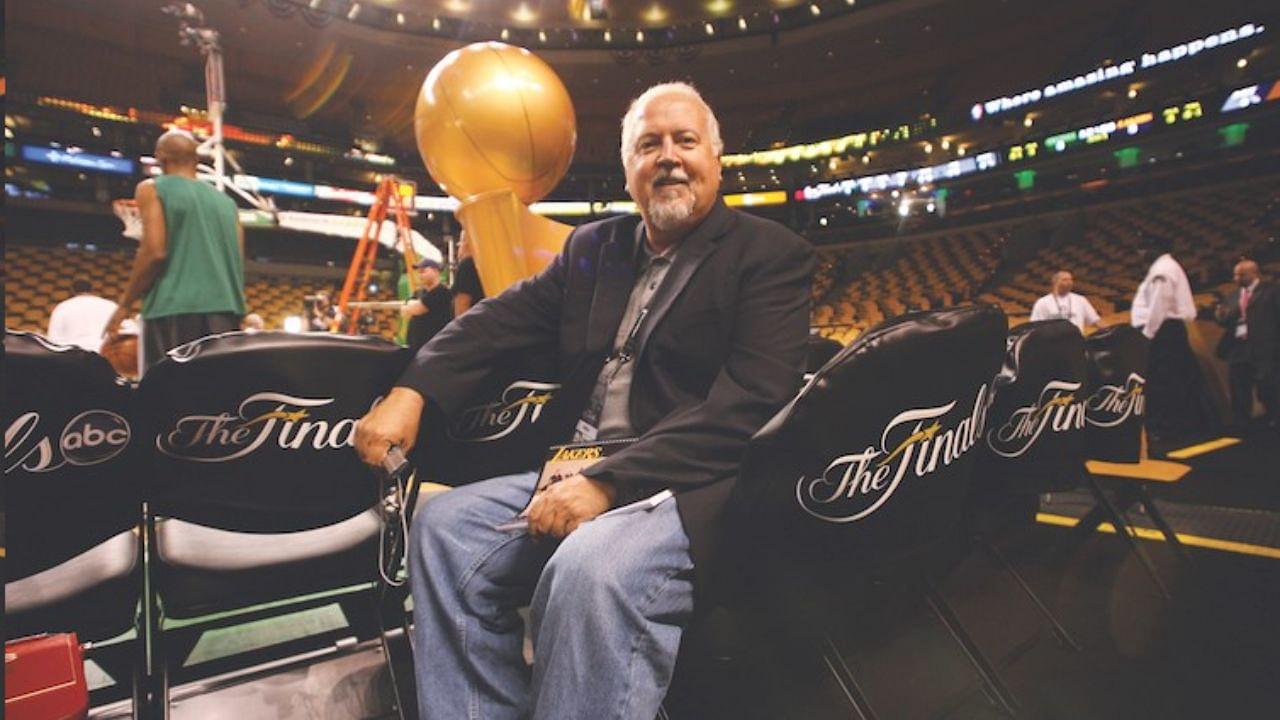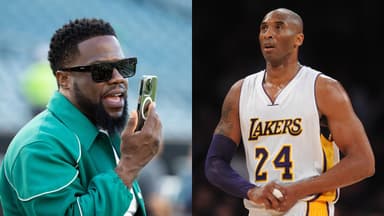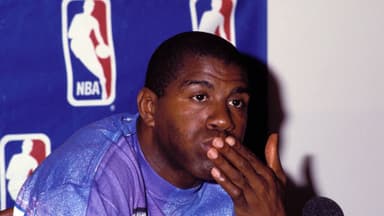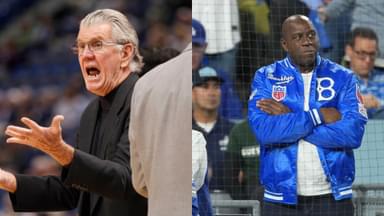The burden of writing a sports icon’s story is heavy, but Roland Lazenby has never shied away from shouldering that burden. For decades, he has taken the stories of some of the greatest names in American sports history right to every fan’s bookshelf. There aren’t many who can write as sublimely, as objectively as him. His distinct narrative style and the context he brings to the table are unique. In an exclusive conversation with The SportsRush, he dives deeper into the significance of this context, of helping preserve the history of the sport. Presenting it as it is, with its rough edges.
Advertisement
Every Michael Jordan, Kobe Bryant, or Magic Johnson fan believes they are familiar with every storyline, every achievement or struggle their favorite player went through. Even for the biggest buff, Lazenby has, without fail, found a way to bring something new to the table. His biography, Michael Jordan: The Life, is the single most important piece of literature on the Bulls legend. He has written about Jerry West, Phil Jackson, Kobe Bryant, and most recently, Magic Johnson, and that’s just the tip of the iceberg. In his own words, Lazenby has been writing for over 45 years, but not all of those years were spent uncovering unheard tales of NBA icons.
Coach, Police Reporter, Sports Editor
Unlike many of the fine and popular reporters today, Lazenby’s journey did not begin in the newsroom or on the court. Well, it did begin on the court, but strictly as a varsity coach. He quit coaching and turned to writing after an unfortunate health scare. Sports writing wasn’t new for the former coach; he had written sports news for a local newspaper earlier. After leaving his coaching and teaching job behind, Lazenby began working as a sports editor for a weekly column. He believes it was a blessing and likely so because it essentially kicked off his journey of covering the NBA.
“I started, I was a high school coach. A varsity coach. And so, I got hired by the local weekly newspaper to begin writing sports. I had a health scare in that period, and I decided then I wanted to be a writer. And so, I had been dabbling in some writing, but I left my teaching and coaching job and became the sports editor of a weekly newspaper, which was quite a blessing. I couldn’t afford to do it long because the wages were low. I already had a family.”
The game changer for Lazenby, however, was news reporting. He began as a night police reporter, covering the criminal activity that plagued the area. From there, he moved to courtroom reporting. It is here he found the skill of being objective, of the importance of context and accurate portrayal of his subjects.
“I started as a night police reporter covering the terrible news that happened in a southern city at night, murders, house fires, car wrecks, things that shattered lives. And then I moved to covering the court system where the cases were being tried for these murders and incidents and seeing the adjudication through the justice system of these cases. And again, sitting in a courtroom with both sides: you might have the murder victim’s family there on one side. On the other side, you have the man accused of committing the murder. And you’re there, in the morning, preparing to write an article for the afternoon paper. And you come back into the courtroom, the paper’s out. You have written that morning thing, and everybody’s ripping through the pages. Some are furious at the events. Others are heartened by the events. But you have to balance things and stick to what is known. The other thing is a healthy respect for all things human. Humanity is the most powerful thing in writing. It’s the thing in so many ways, in so many manners, whatever our prejudices, we are struck by things that are human. They matter to us. And that includes things like the warrior culture or things that intrigue and fascinate us.”
Boston Celtics, Detroit Pistons, the Bulls, and the Lakers
Before the NBA truly blew up, Baseball and Football were the true American sports. They dominated the market, and naturally, people preferred to read about them instead of basketball. But with the rise of the NBA, when Magic and Larry Bird took the game to new heights, the NBA found its way to every television set in the country. By chance or by design, this was also the time Roland Lazenby began his basketball writing career.
He started by writing about college basketball, working alongside the great Billy Packer. Eventually leaving that behind in the late 80s, Lazenby found his way to the Boston Celtics. There, he witnessed some of the biggest names that ever donned the Celtics jersey, “My first NBA experience was covering and writing about the Boston Celtics of Larry Bird and Robert Parish and Dennis Johnson and Kevin McHale and sitting in Boston Garden on the baseline with my press credential, watching those Celtics move the basketball.”
He would go on to cover the Bad Boy Pistons, the Bulls, and then the Lakers. His closeness to the game and its evolution through the decades has allowed the acclaimed writer such insight into the community that it’s barely a surprise that his books pack such a punch.
For all the success Michael Jordan: The Life has brought Lazenby, he has covered more icons from the Lakers than any other team. His biography covering the life and legend of Jerry West paid homage to his father. Showboat, however, was, in a way, a book born of his closeness to the young Bryant, who was lost and lonely in the demanding world of professional basketball.
During the interview, Lazenby detailed the time he was rebounding for Kobe in the Forum and how it inadvertently led to a valuable connection between the young star and Tex Winter.
“I was rebounding free throws for Kobe in the Forum after practice, during the playoffs. It was then he told me that he dreamed of playing for Tex Winter. I about fell over. Tex was my friend. I set up a phone call. Kobe was lost and lonely. Lakers were very unorganized in that season, offensively. And so I got Tex to phone Kobe. And that was a big no-no. Assistant coach Tex still worked for the Bulls. Phil Jackson was gone, but Tex was still an assistant coach. For the assistant coach of one team to phone a young star player of another. Tex was just reaching out as a friend to tell Kobe, ‘Hey, don’t despair. You have a lot of great instincts.'”
The same year, Tex followed Phil Jackson to the Lakers and became an integral part of the Lakers three-peat. It is this closeness to the greats that molded the game, created the history we know and revere today, that makes Lazenby’s writing so striking.
Michael Jordan, Kobe Bryant, and the defining difference
Michael Jordan’s popularity and dominance gave rise to many imitators. None stood the test of time except for one. Bryant’s imitation of his favorite player wasn’t just a wannabe endeavor. It was akin to the work of a highly skilled art forger. Kobe spent hours and hours studying and observing Jordan’s every move and every tic, to the point the resemblance was undeniable.
But as with every great art forger, some things are so innately different that they are impossible to mimic, to recreate. Lazenby was kind enough to articulate these differences between the two.
“Michael was much stronger in the post. Kobe could post up and the triangle creates that post weapon. Ultimately when the ball gets to the weak side, Michael’s going to post up. He’s going to be able to turn and get that shot. There are various ways Michael became the post-weapon in the triangle and Kobe wanted to be that post-weapon. He wasn’t quite as strong as Michael in holding position. Michael leaning back and having the strength, particularly when he began weight training, even more in the wake of all those losses to the Pistons, that tremendous strength he gained made him an even greater post weapon. Like Shaq was so strong. Kobe wanted to be down there and he was learning, but he was skinnier. Tex pointed out, and this is a complicated answer, but Tex pointed out, Michael’s hands were a little bigger. Kobe never let that limit him.”
But the major difference, Roland Lazenby revealed, was the path each took to the NBA. While Jordan went to College and played at North Carolina under Dean Smith before playing in the NBA, Kobe came to the league right out of High School.
“The real thing that made the difference in Tex’s mind was that Michael Jordan went to college and played three years of college ball. Now what people don’t understand, he played at North Carolina, which was a system basketball program. He dunked against Maryland and Dean Smith wouldn’t even show the video of it on his coach’s show. It was a system that tightly controlled things.”
For Kobe, it wasn’t as simple. Deloris and James Jordan’s role in mapping out Michael’s path to success was foolproof. They were thinking beyond just basketball and money at every step and every move. Kobe never had that luxury.
“He [Tex Winter] said that Kobe didn’t go to college. Kobe had very mixed feelings about that. He wanted to go play for Mike Krzyzewski [Coach K] at Duke, but his parents, what people didn’t realize, his parents were badly in need of money. Sonny Vaccaro, who had been fired by Nike mysteriously, was with Adidas and Sonny told me and explained for my book about Kobe, Showboat, that the most clandestine thing he did was they stalked once they realized Kobe was Kobe. Sonny had a vendetta against the NCAA or college basketball and a vendetta against Nike, as he explained it to me. Sonny being of Italian heritage, the vendetta is a big thing. He wanted to steal the next great star from college basketball and from Nike. And so he accomplished that. The spring of Kobe’s senior year in high school, right after he’d finished the season and won a championship, Adidas had a contract for Kobe.”
The Process of letting an idea grow
Lazenby’s ability to break through the chaos and bring what is hidden behind the curtain to the stage is similar to a thoroughly practiced choreography routine. He has gone through the process of researching, structuring, and writing countless stories countless times. Though it may feel like it comes naturally to him, in his mind, his process is unmistakable. He says taking on a challenge and allowing an idea to grow has dictated his style.
“You know, a lot of my own personal understanding, when you take on projects as a writer, you learn so much from those projects. And as a writer, I would take on all challenges. That came from being a newspaper reporter. I had to report on an array of things. I generally believe that writing is idea-driven. And so I did learn from one of my mentors about the development of ideas. And so my ideas about stories created opportunity for me at that time, starting in the 1970s, and on through the 1980s, ’90s. My ideas would push me ahead in the competition within the media world because I learned to develop ideas, and then to make proposals and to sell those ideas.”
In a single lifetime, Lazenby has managed to be a varsity coach, a news reporter, a sports editor for a weekly, and a college professor. These experiences are not to be taken lightly, for they are distinctly visible in every book he has written.
5 years dedicated to Magic Johnson’s Story but Roland Lazenby refuses to stop
In 2023, he released MAGIC: The Life of Earvin ‘Magic’ Johnson. It took him 5 years to pen down the 800-page book. The tremendous effort that went into it is inconceivable to a fan. But even at 71, it has failed to deter the writer from taking on more projects.
“I’m an idiot for trying to publish an 800-page book on Magic Johnson” My interview with Baltimore’s Glen Clark.https://t.co/3P21mNoDtQ
— Roland Lazenby (@lazenby) October 26, 2023
Lazenby confesses his wife wants him to stop but, in the same breath, names three more major projects that have left the harbor: one about former commissioner David Stern and another about the Lakers. And the last one as a producer on a documentary covering the early life of LeBron James. It’s fair to assume there are ample books to be expected of him but the anticipation of who might be the next is palpable.








